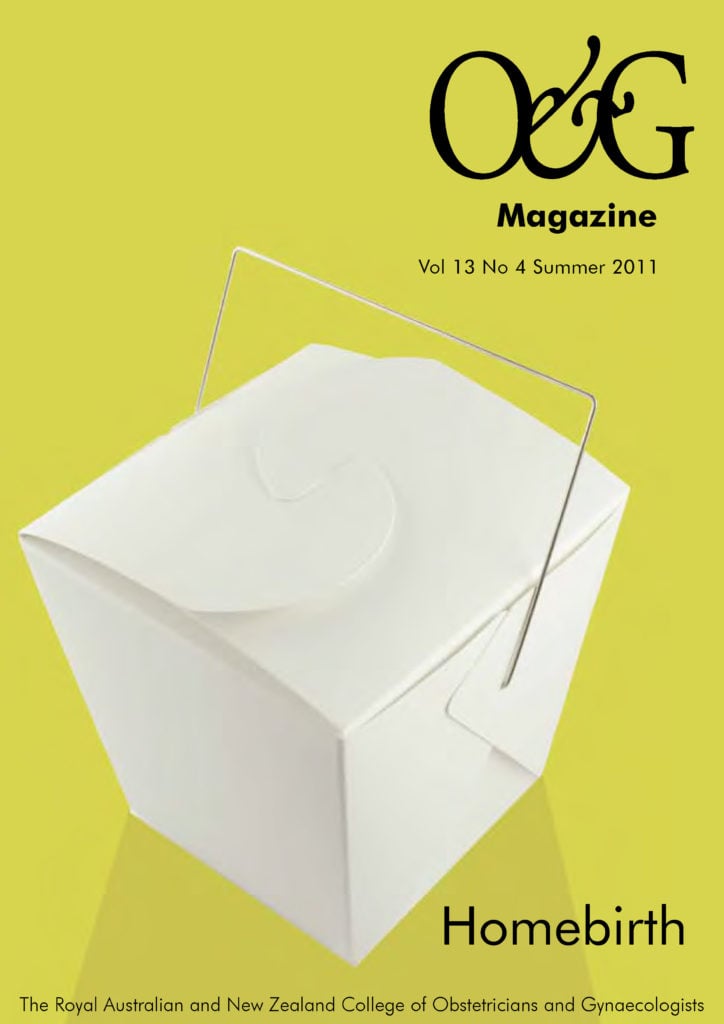Regular readers of O&G Magazine will know that the editorial team does not shy away from controversy. Publication of material dealing with contentious topics in reproductive health is grist to our mill – a vital part of the magazine’s existence. In recent years we have devoted issues to death, religion, ethics and blood; we have discussed abortion and published viewpoints for and against caesarean section on request. No topic in our specialty, however, seems to inflame the passions, excite controversy and polarise opinion in quite the same way as this one. Despite the fact that fewer than one baby in a hundred is born at home in Australia, hardly a week passes without the subject appearing somewhere in the mainstream media. As we go to press, Midwives Australia has issued a public statement lamenting the lack of Commonwealth Government support for independent homebirth midwives in Australia. The group claims that this is leading to more midwives dropping their midwifery registration and becoming doulas, so they can attend homebirths.
In view of the enormous amount of attention paid to homebirth in the lay and medical press, it is timely to publish an issue devoted to homebirth. In preparing it, we approached a large number of people to write for us, in order to solicit a wide range of viewpoints. Normally those we ask to write for O&G Magazine are happy to do so. However, on the topic of homebirth many declined, citing the political and social fallout that might follow. Those who declined include not only Fellows of our College with a known interest in the subject, but also the Australian Commonwealth Health Minister, Ms Nicola Roxon, among others. We are most grateful to all those who did accept the invitation and whose work appears in this issue.
The team here at O&G Magazine appreciates that there is unlikely ever to be consensus on this topic, but we hope that by including a variety of views in a single issue of the magazine we may progress somewhat in an exchange of opinion. We therefore offer articles by midwives, obstetricians, academics and women who have been there, to provide what we hope is a comprehensive overview of the subject of planned homebirth, supervised by registered midwives, in an Australian and New Zealand setting.
Many authors have noted that there is a lack of good evidence on the safety of homebirth in developed countries – and we see this as one indisputable fact to emerge from the issue. At the same time, it is important to use what evidence there is. Many of our authors have done this; but, as readers will find, interpretations of that evidence can differ markedly.
New Zealand differs from Australia in that legislation changed in 1991, allowing independent midwifery practice. This developed out of a political ideal supporting women’s choice. As a result, homebirth is available in New Zealand today as a woman’s choice and, as the New Zealand-based articles suggest, homebirth and risk assessment, with informed choice, go hand in hand.
Unfortunately, data from New Zealand are also limited; it is only in the last few years that we have accurate information on national maternal and perinatal mortality. However, as this audience is well aware, when reviewing data on homebirth safety this has to include ‘near misses’ and these data are incomplete and often inconsistently collected.
The issues around homebirth in New Zealand are by no means resolved, but there is more discussion, encouraging homebirth midwives to be trained, experienced and under the same regulatory body as hospital-based midwives. However, the secret of success for any model of care has to be collaborative work; no one works in isolation. Midwives specialise in the normal, while obstetricians specialise in the deviation from this; homebirth is no exception.
It is important to note that we are discussing homebirth in developed countries, where women are fortunate to have the skills and experience of properly trained doctors and midwives available. Our second article from Médecins Sans Frontières deals with the lack of choice in childbirth experienced by the majority of the world’s women, above all those living in developing countries (see p50). Only a brief plane flight away in Papua New Guinea, most women have a homebirth because there is nothing else. Only a small proportion receive any antenatal care and even fewer give birth in a hospital or clinic; the result is a maternal mortality rate 100 times that of Australia and New Zealand. We need to see the provision of homebirth in Australia and New Zealand in a global context.






Leave a Reply